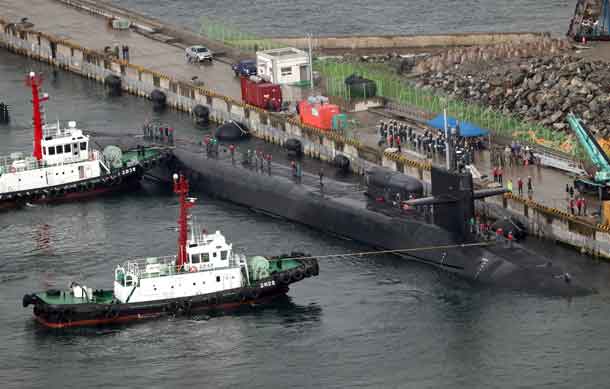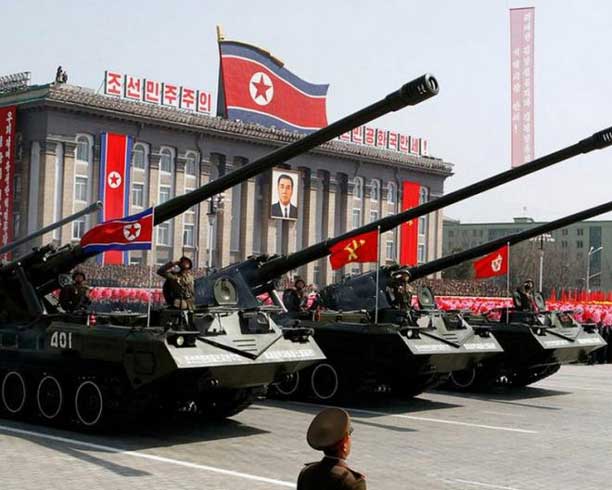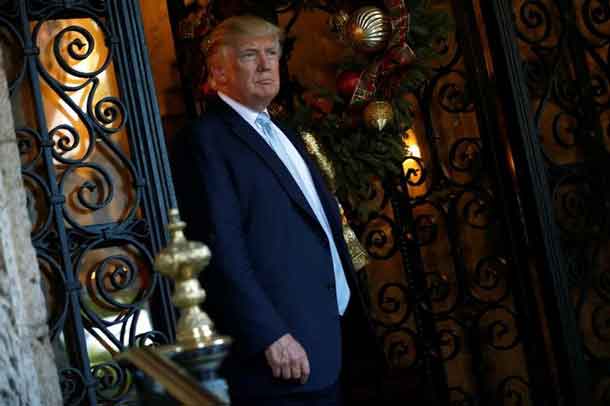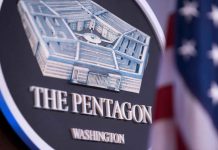

By Ju-min Park
SEOUL (Reuters) – North Korea conducted a big live-fire exercise on Tuesday to mark the foundation of its military as a U.S. submarine docked in South Korea in a show of force amid growing concern over the North’s nuclear and missile programmes.
The port call by the USS Michigan came as a U.S. aircraft carrier strike group steamed towards Korean waters and as top envoys for North Korea policy from South Korea, Japan and the United States met in Tokyo.
Fears have risen in recent weeks that North Korea would conduct another nuclear test or long-range missile launch in defiance of U.N. sanctions, perhaps on the Tuesday anniversary of the founding of its military.
But instead of a nuclear test or big missile launch, North Korea deployed a large number of long-range artillery units in the region of Wonsan on its east coast for a live-fire drill, South Korea’s military said. North Korea has an air base in Wonsan and missiles have also been tested there.

“North Korea is conducting a large-scale firing drill in Wonsan areas this afternoon,” the South’s Office of Joint Chiefs of Staff said in a statement.
The South Korean military was monitoring the situation and “firmly maintaining readiness”, it said.
The South’s Yonhap News Agency said earlier the exercise was possibly supervised by North Korean leader Kim Jong Un.
North Korea’s state media was defiant in a commentary marking the 85th anniversary of the foundation of the Korean People’s Army, saying its military was prepared “to bring to closure the history of U.S. scheming and nuclear blackmail”.
“There is no limit to the strike power of the People’s Army armed with our style of cutting-edge military equipment including various precision and miniaturised nuclear weapons and submarine-launched ballistic missiles,” the official Rodong Sinmun newspaper said in a front-page editorial.
North Korea’s growing nuclear and missile threat is perhaps the most serious security challenge confronting U.S. President Donald Trump.
Trump has vowed to prevent North Korea from being able to hit the United States with a nuclear missile and has said all options are on the table, including a military strike.
He sent the USS Carl Vinson aircraft carrier strike group for exercises in waters off the Korean peninsula as a warning to North Korea and a show of solidarity with U.S. allies.
South Korea’s navy said it was conducting a live-fire exercise with U.S. destroyers on Tuesday in waters west of the Korean peninsula and would soon join the carrier strike group approaching the region.
Japan’s Chief Cabinet Secretary Yoshide Suga told media that China’s envoy for Korean affairs, Wu Dawei, would hold talks with Japanese Foreign Ministry officials. A ministry source said Wu was likely to meet his Japanese counterpart, Kenji Kanasugi, on Wednesday.
Kanasugi said after talks with his U.S. and South Korean counterparts that they all agreed China should take a concrete role to resolve the crisis and it could use an oil embargo as a tool to press the North.
“We believe China has a very, very important role to play,” said the U.S. envoy for North Korea policy, Joseph Yun.
South Korea’s envoy, Kim Hong-kyun, said they had also discussed how to get Russia’s help to press North Korea.
Japanese Prime Minister Shinzo Abe is expected to meet Russian President Vladimir Putin on April 27, the Kremlin said. It did not elaborate.
Matching the flurry of diplomatic and military activity in Asia, the State Department in Washington said on Monday U.S. Secretary of State Rex Tillerson would chair a special ministerial meeting of the U.N. Security Council on North Korea on Friday.
Tillerson, along with Defense Secretary Jim Mattis, Director of National Intelligence Dan Coats and Joint Chiefs chairman General Joseph Dunford, would also hold a rare briefing for the entire U.S. Senate on North Korea on Wednesday, Senate aides said.
A North Korean foreign ministry spokesman said those meetings called by U.S. officials clearly reflected the U.S. pressure that could “ignite a full-out war” on the Korean peninsula.
“The reality of today again proves the decision to strengthen nuclear power in quality and quantity under the banner of pursuing economic development and nuclear power was the correct one,” the unidentified spokesman said in a statement issued by the North’s state media.
On Monday, Trump called for tougher U.N. sanctions on the North, saying it was a global threat and “a problem that we have to finally solve”.
“The status quo in North Korea is also unacceptable,” Trump told a meeting with the 15 U.N. Security Council ambassadors, including China and Russia, at the White House. “The council must be prepared to impose additional and stronger sanctions on North Korean nuclear and ballistic missile programmes.”
The official China Daily said on Tuesday it was time for Pyongyang and Washington to take a step back from harsh rhetoric and heed voices of reason calling for a peaceful resolution.
“Judging from their recent words and deeds, policymakers in Pyongyang have seriously misread the U.N. sanctions, which are aimed at its nuclear/missile provocations, not its system or leadership,” the newspaper said in an editorial.
“They are at once perilously overestimating their own strength and underestimating the hazards they are brewing for themselves,” it said.
In a phone conversation with Trump on Monday, Chinese President Xi Jinping called for all sides to exercise restraint.
As the carrier group drills continued, the USS Michigan arrived in the South Korean port of Busan on Tuesday, the U.S. Navy said. The nuclear-powered submarine is built to carry and launch ballistic missiles and Tomahawk cruise missiles.
As well as his military show of force, Trump has sought to press China to do more to rein in its nuclear-armed neighbour.
China, North Korea’s sole major ally, has in turn been angered by Pyongyang’s belligerence, as well as its nuclear and missile programmes.
(Additional reporting by Ben Blanchard in BEIJING, Kaori Kaneko, Linda Sieg, Elaine Lies and Tim Kelly in TOKYO, and Steve Holland, Matt Spetalnick, Susan Heavey and David Brunnstrom in WASHINGTON, Vladimir Soldatkin in MOSCOW; Writing by Jack Kim; Editing by Paul Tait, Robert Birsel)






